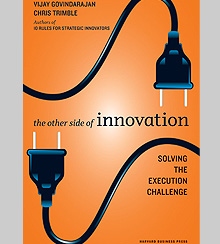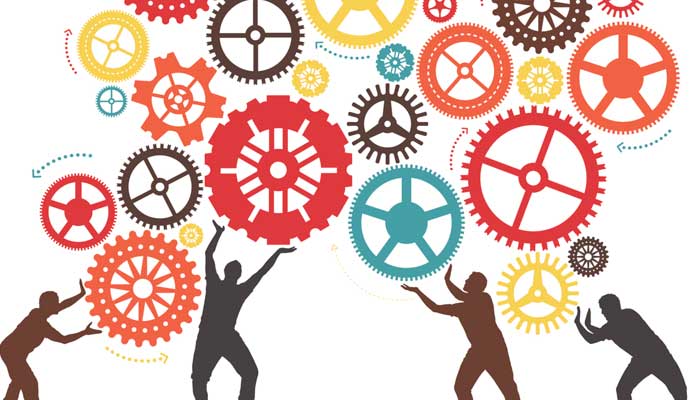How Learning Leads to Results
Matthew E. May, author of The Shibumi Strategy: A Powerful Way to Create Meaningful Change, introduces a passage on the critical role of a learning focus in innovation from The Other Side of Innovation: Solving the Execution Challenge, by Vijay Govindarajan and Chris Trimble.
Learning and innovation cannot be separated. That’s why low-resolution prototyping is a critical part of the innovation process, because every savvy designer knows that before anyone can improve or innovate anything, learning must take place. In fact, there isn’t a successful design firm in the world that doesn’t elevate to gospel the “fail fast and learn” principle.
Although learning and innovation are closely linked, learning comes first. The great innovators understand that it is learnership that results in leadership. Nonetheless, as Vijay Govindarajan and Chris Trimble make clear in The Other Side of Innovation, learning is misunderstood and undervalued, even in the most innovative companies. Why? Because of an overly intense focus on the ends rather than the means of innovation execution.
Learnership is all about the beta. It is an acquired capability, a teachable discipline. It requires developing a strong skill and a sound process. In this passage, Govindarajan and Trimble provide a precise and valuable definition of learning — and a reason that innovators should pay attention to it.
— Matthew E. May
An excerpt from Chapter 4 of The Other Side of Innovation:
Solving the Execution Challenge
When we speak with executives about the overriding importance of learning from experiments, we sometimes sense a degree of impatience. The overwhelming goal, in the minds of some, is not learning; it is results. Learning is a soft and squishy objective; results, on the other hand, are what business is all about.
We sympathize with that point of view. Learning, as an outcome, can sound like a consolation prize. “Sorry that the project failed, boss, but let me tell you, we learned a ton.” We get it. With innovation, however, placing primary focus on learning rather than results actually leads to better results.
We are not talking about learning in a general, feel-good sense. We are talking about a very specific type of learning. For our purposes, learning is the process of turning speculative predictions into reliable predictions.
Companies launch innovation initiatives when predicted outcomes justify the investment. But these predictions are based on assumptions. They are guesses. In some cases, they are wild guesses. As you learn, you convert assumptions into knowledge. Wild guesses become informed estimates, and informed estimates become reliable forecasts. The best indicator that you are learning is that your predictions get better.
To see how learning leads to results, consider two companies that invest in the same innovation initiative. Both have identical plans. The odds of success are roughly one in three. The first company maintains a traditional focus on results. The second, instead, focuses on learning.
In the first company, because there is no learning process in place, the leaders of the innovation initiative stick to the original plan — a plan composed at a time when there was little data, just guesses. When results start to fall short of predictions, the innovative leader becomes defensive. Knowing that the only acceptable outcome is success, the leader obfuscates unpleasant data and focuses on persuading decision makers to continue the investment, perhaps spinning a far-fetched story about how the initiative can still succeed. If the leader is convincing, the company continues to invest and continues down a road to eventual and expensive failure. Disastrous though this may be, it may not be the end of the story. The stinging aftermath of failure makes it unlikely that the company will retain the right lessons learned. Indeed, it may launch a second innovation initiative based on the same faulty premises.
In the second company, leaders of the initiative openly discuss results and question the original assumptions in the plan. As they learn, they update their predictions. When it becomes clear that the original assumptions were wrong and the original predictions are unrealistic, the company engages in a conversation about what to do next. Should it abandon the experiment? Alter the plan to change directions? Either way, it will achieve results that are better than the first company’s. If the initiative fails, it will fail earlier and at a lower cost. Or, if the second company sees a way to change directions to increase the odds of success, it might actually succeed. Each revision of the plan is based on more data and fewer assumptions. The picture gets clearer each time.
Learning is making better predictions, and the ability to make better predictions is imminently and immediately practical. When executives shy away from learning as a managerial objective in favor of being tough and demanding results, they are not being hard-nosed; they are just hardening the path to failure.
Some experiments will fail. That is inevitable. There is never any excuse, however, for not learning in a quick and disciplined fashion. Doing so minimizes the cost of failure and maximizes the probability of success.
— Vijay Govindarajan and Chris Trimble
Excerpted from The Other Side of Innovation: Solving the Execution Challenge, by Vijay Govindarajan and Chris Trimble (Harvard Business Review Press, 2010), with permission from the publisher.




